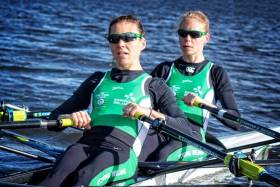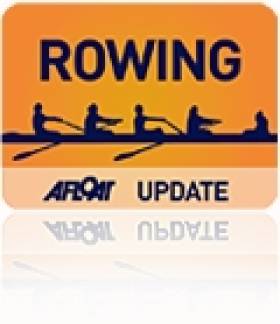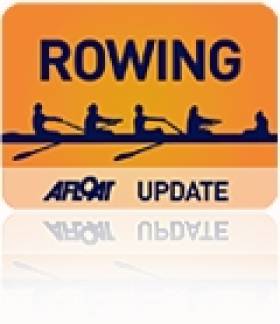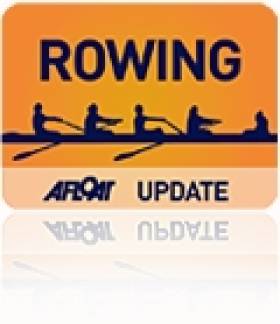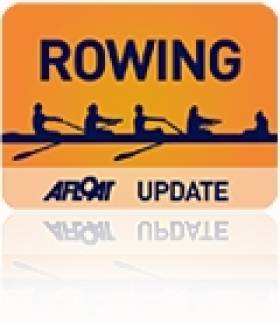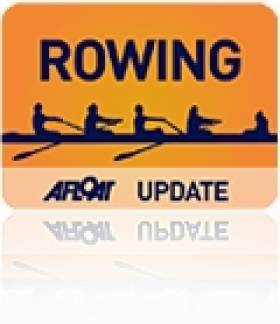Displaying items by tag: McCrohan
Jennings and Lambe Win C Final at World Cup in Varese
#Rowing: Sinéad Jennings and Claire Lambe ended their campaign at the World Cup Regatta in Varese with a commanding performance to win the C Final of the lightweight double sculls. They led all the way and were four lengths clear of nearest rivals, Italy Three, at the finish.
Ireland had two competitors in the repechage of the women’s lightweight single sculls. There were two places on offer in an A Final, but Poland and Switzerland One took these. Siobhán McCrohan finished fifth and Denise Walsh sixth. In the lightweight men’s four, Ireland battled it out for third in the C Final with Austria, losing out by .15 of a second. In the C Final of the women’s pair, Leonora Kennedy and Barbara O’Brien finished third. Norway pipped Ukraine to win.
World Cup Regatta, Varese – Day Two (Selected Results, Irish interest)
Men
Lightweight Four – C Final (places 13 to 16): 1 Canada One 6:09.73, 2 Serbia 6:11.21, 3 Austria 6:15.85, 4 Ireland (L Seaman, M O’Donovan, L Keane, S O’Driscoll) 6:16.00.
Women
Pair – C Final (places 13 to 16): 1 Norway One 7:22.74, 2 Ukraine 7:23.16, 3 Ireland (L Kennedy, B O’Brien) 7:33.07.
Lightweight Double Sculls – C Final (places 13 to 17): 1 Ireland (C Lambe, S Jennings) 7:17.24, 2 Italy Three 7:26.29, 3 Chile 7:29.71.
Lightweight Single Sculls – Repechage (First Two to A Final; rest to B Final): 1 Poland Two 7:49.90, 2 Switzerland One 7:51.76; 5 Ireland Two (S McCrohan) 8:04.69, 6 Ireland One (D Walsh) 8:08.81
#Rowing: Ireland ended the first session of the World Cup in Varese with two heat wins and five crews set for the second chance of the repechages. Siobhan McCrohan finished fourth in her heat of the lightweight single sculls and Denise Walsh one place further back in her heat.
The men’s lightweight four finished fourth in their heat. The race was won by Italy Two, with the United States One second. Ireland placed fourth down the course, ahead of fifth-placed Austria One.
World Cup Regatta, Varese (Selected Results, Irish interest)
Men
Lightweight Four – Heat Three (First Two to A/B Semi-Final; rest to Repechages): 1 Italy Two 6:00.40, 2 United States 6:00.95; 4 Ireland (L Seaman, M O’Donovan, L Keane, S O’Driscoll) 6:18.75
Lightweight Double Sculls – Heat Three (First Two to A/B Semi-Final; rest to Repechages): 1 Ireland (P O’Donovan, G O’Donovan) 6:27.07, 2 Britain 6:33.38; 3 Netherlands Two 6:48.24.
Women
Pair – Heat One (First Two to A/B Semi-Final; rest to Repechages): 1 Germany 7:23.08, 2 Russia One 7:24.46; 5 Ireland (L Kennedy, B O’Brien) 7:46.38.
Lightweight Double Sculls – Heat Two (First Two to A/B Semi-Final; rest to Repechages): 1 Switzerland 7:03.98, 2 Canada 7:04.45; 3 Ireland (C Lambe, S Jennings) 7:05.0.
Single Sculls – Heat One (Winner to A/B Semi-Finals; rest to Repechages): 1 Ireland (S Puspure) 7:34.32; 2 Czech Republic (M Knapkova) 7:36.13.
Lightweight Single Sculls – Heat One (First Two to A/B Semi-Final; rest to Repechages): 1 Netherlands Two 7:40.25, 2 Italy 7:45.99; 4 Ireland Two (S McCrohan) 8:02.38.
Heat Two (First Two to A/B Semi-Final; rest to Repechages): 1 Canada 7:42.41, 2 Netherlands One 7:45.30; 5 Ireland One (D Walsh) 8:11.91.
McCrohan and UCD/Old Collegians Composite Win in Cork
#Rowing: Siobhan McCrohan won the won the women’s senior single sculls for Tribesmen and the experienced Old Collegians/UCD crew took the men’s senior quadruple at the Irish Championships this afternoon.
In the junior women’s eight, Portora had to see off a challenge by Bann, while Shandon bested Castleconnell in an exciting race to win the junior men’s quadruple – their third in-a-row.
Queen’s won the men’s novice eight, beating UCD and Trinity, while Margaret Cremin of Lee won the club single sculls and Andrew Goff of Waterford the men’s intermediate single.
Irish Rowing Championships, National Rowing Centre, Cork (Day Two, Selected Results)
Men
Eight – Intermediate: 1 Trinity 5:46.51, 2 UCD A 5:49.27, 3 Queen’s 6:08.61. Novice: 1 Queen’s 6:18.97, 2 UCD 6:25.66, 3 Trinity 6:38.63.
Four – Junior, coxed: 1 Portora 6:36.84, 2 St Joseph’s 6:37.0, 3 Athlunkard 6:45.18.
Pair – Senior: 1 UCC 7:03.18, 2 NUIG 7:10.16, 3 Carlow 7:12.51.
Sculling, Quadruple – Senior: 1 Old Collegians/UCD 6:07.97, 2 Commercial 6:14.51. Junior: 1 Shandon 6:16.78, 2 Castleconnell 6:17.49, 3 Cork BC A 6:28.24.
Single – Intermediate: 1 Waterford (A Goff) 7:23.95, 3 Athlone (P Munnelly) 7:34.43. Club: 1 Shandon (C Merz) 7:42.94, 2 Clonmel (D Lynch) 7:44.96, 3 Lee (D Larkin) 7:45.94.
Women
Eight – Novice: 1 Commercial 6:59.55, 2 Queen’s 7:13.67, 3 Trinity 7:13.67. Junior: 1 Portora 6:49.43, 2 Bann 6:52.99, 3 Shannon 7:13.95.
Sculling, Double – Intermediate: 1 Skibbereen 7:36.62, 2 St Michael’s 7:45.87, 3 Belfast BC 7:48.80.
Single – Senior: 1 Tribesmen (S McCrohan) 8:06.29, 2 Commercial (Sarah Dolan) 8:12.04, 3 Skibbereen (O Hayes) 8:13.99. Club: 1 Lee (M Cremin) 8:33.88, 2 Garda (J Ryan) 8:46.29, 3 Queen’s (R Brown) 8:51.52. Junior: 1 Cork (D Forde) 8:07.98, 2 Skibbereen (E Hegarty) 8:18.01, 3 Offaly (A Mooney) 8:21.91.
#ROWING: The battle for the final place on the Ireland team for the European Championships in Poznan next weekend ended with victory for Sinead Jennings. The St Michael’s woman beat Siobhan McCrohan of Tribesmen in a shootout at the National Rowing Centre. The two women had both targeted the lightweight single sculls place at Poznan. Jennings, a former world champion in the lightweight single, has never won a European medal.
#ROWING: Siobhán McCrohan and Sinéad Jennings dead-heated in the shoot-out for the place in the lightweight single sculls at the European Championships. The race was held over 1500 metres because of a powerful tailwind at the National Rowing Centre, and neither sculler could draw clear of the other in a stirring contest. McCrohan started and finished well, while Jennings did well in the middle stages. The two are set to race again over 1500 metres on Friday or Saturday.
McCrohan a Record Breaker in Indoor Rowing
#ROWING: Siobhán McCrohan set a new record for Irish lightweight women in indoor competition at the Irish Provinces Indoor Rowing Championships at the University of Limerick. The Tribesmen athlete clocked seven minutes 15.2 seconds for the 2,000 metres. The standing record was 7:16.8, set by Claire Lambe in 2010.
The best men’s open time was 6:10.2, taken by Kevin Coughlan of Carlow, and Jonathan Doyle won the lightweight open section in 6:28.1. There was a record time for 500 metres in the men’s lightweight 50-59 category. Christian Leonard set a time of one minute 34.5 seconds. SELECTED RESULTS
| Mens 2k |
| MO 1 Kevin Coughlan_Carlow 06:10.2 2000 |
| MO 2 David Meehan_SMRC 06:11.3 2000 |
| MO 2 Dan Hindle_NUIG 06:11.3 2000 |
| LMO 1 Jonathan Doyle_PaddyPower_IRC 06:28.1 2000 |
| LMO 2 Alan Mc_Kenna_Carlow 06:38.3 2000 |
| LMO 3 Alan Goodison_Fermoy_RC 06:53.3 2000 |
| Current Irish Record: |
| 2000 19-29 Eamon Joyce M Hwt U.C.C.R.C. 5:59.3 2001 Race result |
| 2000 19-29 Paul Griffin M Lwt Muckross RC 6:16.4 2001 Race result |
| Womens 2k |
| LWO 1 Siobhan McCrohan_Tribesmen_RC L 07:15.2 2000 |
| LWO 2 Amy Bulman_UCCRC 07:48.2 2000 |
| WU23 1 Deirdre O'Sullivan_UCCRC 07:17.9 2000 |
| WU23 2 Caoimhe Joyce-Hearne_NUIG 07:20.4 2000 |
| WU23 3 Hannah O'Sullivan_SMRC 07:23.6 2000 |
| WO 1 Aine Collins_Fermoy_RC 07:23.7 2000 |
| WO 2 Jessica O'Keeffe_SMRC 07:25.4 2000 |
| WO 3 Marie Piggot_NUIG 07:39.4 2000 |
| Current Irish Record: |
| Claire Lambe Lwt UCDBC 7:16.8 2010 Race result |
| Mens 500 |
| New Irish Record : LM50-59 Christian Leonard_ 01:34.5 500 |
| Old Record: LM50-59_500 Joe Keating M Lwt London 1:41.1 2008 Historical Record |
#ROWING: Two of the big wins of the evening session of finals at the Irish Rowing Championships at the National Rowing Centre in Cork came to crews with very different levels of experience.
The Cork Boat Club junior women’s eight made a breakthrough for the club at this level by beating Portora and Bann in a fine race. The senior men’s quadruple was taken by the crew of Albert Maher, Sean Jacob, Con Collis and Michael Maher, who held off a challenge from the Castleconnell/University of Limerick crew. Jacob and Maher are both in their forties and have over 40 ‘Pots’ between them.
The women’s senior pair was won by Barbara O’Brien and Aifric Keogh, representing NUIG, while Sarah Quinn of Belfast Boat Club won the Club singles.
The junior men’s quadruple gave Shandon’s young crew – two are junior 17 athletes and one a junior 16 – a fine win over Skibbereen, who faltered before the finish.
The women’s lightweight single sculls final turned into a battle between Claire Lambe of Old Collegians and Siobhán McCrohan of Tribesmen, with the Dubliner coming out on top.
Turlough Hughes of UCD had a remarkably straightforward win over David O’Malley of St Michael’s in the men’s intermediate single sculls, while UCD held off a late charge by Queen’s to win the men’s novice eight.
Irish Rowing Championships, National Rowing Centre, Cork (Selected Results; Finals)
Men
Eight – Intermediate: 1 Trinity 5:46.25, 2 NUIG 5:50.28, 3 UCD 5:56.96. Novice: 1 UCD 6:59.50, 2 Queen’s 7:02.31, 3 Trinity 7:03.29.
Four, coxed – Junior: 1 Cork BC 6:35.99, 2 Presentation 6:36.22, 3 Portora 6:38.08.
Pair – Senior: 1 UCD (M O’Donovan, N Kenny) 6:46.05, 2 NUIG 6:49.95, 3 Commercial B 7:00.16.
Sculling, Quadruple – Senior: 1 Old Collegians/Commercial (C Collis, S Jacob, A Maher, M Maher) 5:59.84, 2 Castleconnell/University of Limerick 6:00.60, 3 Queen’s 6:07.90.
Junior: 1 Shandon 6:08.24, 2 Athlone 6:13.34, 3 Skibbereen 6:15.52.
Single – Intermediate: 1 UCD (T Hughes) 7:13.0, 2 St Michael’s (O’Malley) 7:20.72, 3 NUIG (O’Connor) 7:25.14. Club: Lee (D O’Sullivan) 7:31.80, 2 St Michael’s (P O’Connor) 7:36.24, 3 Belfast BC (A Murray) 7:39.44.
Women
Eight – Novice: 1 Queen’s 7:19.74, 2 Trinity 7:55.75. Junior: 1 Cork BC 6:39.32, 2 Portora 6:41.90, 3 Bann 6:45.27.
Sculling, Double – Intermediate: 1 Killorglin (F Foley, M Dukarska) 7:17.17, 2 Commercial 7:20.83, 3 Skibbereen 7:39.99.
Pair – Senior: 1 NUIG (B O’Brien, A Keogh) 7:33.89, 2 St Michael’s 7:42.32, 3 Shannon 7:42.48.
Single – Lightweight: 1 Old Collegians (C Lambe) 7:41.70, 2 Tribesmen (McCrohan) 7:43.80, 3 Skibbereen (Hayes) 8:01.34. Club: 1 Belfast (S Quinn) 8:09.22, 2 Queen’s (Edwards) 8:10.61, 3 Lee (McGuire) 8:39.69.
Junior: 1 Cork BC (O Forde) 8:06.14, 2 Belfast BC (J English) 8:07.11, 3 Commercial B 7:00.16.
Lightweight Rowers Top Rankings at Ireland Trial
#ROWING: Irish rowing grabbed a few hours of relative calm between spells of gusting wind to stage the second session of the Ireland Trial at Newry Canal today. Lightweight single sculler Siobhán McCrohan (26) again topped the overall rankings – bettering her per centage of projected world gold medal winning time set on Saturday.
Paul O’Donovan and Sanita Puspure also confirmed their good form, with O’Donovan teaming up to good effect with Shane O’Driscoll in a lightweight double scull. One of the most encouraging aspects of the weekend was the evidence of a breadth of talent in the lightweight men’s category – Anthony English did well today, and Niall Kenny was not far behind.
Ireland Trial, Newry Canal (Run over 5km; Selected Results)
(Percentage is of projected world gold medal winning time)
Saturday
Men
Pair – Senior: 1 D Neale, C Folan 18 minutes 41.53 seconds (82.03), 2 D Power, P O’Connell 18:53.62 (81.6). Under-23: 1 R O’Callaghan, R Bennett 18:29.53 (82.92), 2 M Pukelis, K Neville 19:23.43 (79.08). Junior: D Keohane, B Keohane 19:06.58 (80.24), 2 Murphy, O’Connell 19:26.23 (78.89), 3 Fallon, Bennett 19:32.47 (78.47).
Lightweight: 1 Quinlan, O’Connor 19:27.59 (81.36), 2 McKenna, Murphy 19:30.72 (81.15), 3 Keane, Breen 19:32.55 (81.02).
Sculling,
Single – Senior: 1 J Keohane 19:16.47 (84.31), 2 A McEvoy 19:37.34 (82.81). Under-23: 1 T Oliver 19.47.82 (82.08), 2 A Harrington 19:52.47 (81.76), 3 S McKeown 20:06.03 (80.84). Junior: 1 D O’Malley 19:41.55 (82.5), 2 C Carmody 19:57.29 (81.43), 3 C Hennessy 20:15.6 (80.21).
Lightweight – Senior: 1 N Kenny 19:18.40 (86.33), 2 J Ryan 19:28.13 (85.61), 3 M O’Donovan 19:30.07 (85.46). Under-23: P O’Donovan 19:05.46 (87.3), 2 S O’Driscoll 19:26.18 (85.75), 3 C Beck 19:41.35 (84.65).
Women
Four – Senior: Deasy, McCarthy, O’Brien, Leahy 19:51.76 (84.33).
Pair – Senior: L Dileen, A Keogh 20:12.32 (84.14), 2 Bennett, Gilligan 21:28.79 (79.14). Under-23: G Collins, O Finnegan 21.05.13 (80.62). Junior: 1 K O’Connor, H Hickey 21:43.08 (78.28), 2 Clarke, Glover 21:54.75 (77.58), 3 Nagle, O’Keeffe 22:33.06 (75.38).
Sculling
Single – Senior: 1 S Puspure 20:21.36 (86.99), 2 M Dukarska 2:40.57 (85.65), 3 E Moran 21:20.92. Under-23: 1 C Fitzgerald 21.50.12 (81.10), 2 H O’Sullivan 22:14.21 (79.64), 3 M Dineen 22:27.69 (78.84). Junior: 1 E Lambe 21:47.62 (81.25), 2 J English 21:54.17 (80.85), 3 E Barry 22:03.17 (80.30).
Lightweight – Senior: 1 S McCrohan 20:58.15 (87.43), 2 C Jennings 21:15.24 (86.26), 3 O Hayes 21:18.60 (86.03). Under-23: 1 R Morris 21:32.68 (85.09), 2 S Horgan 21:47.18 (84.15).
Sunday
(Provisional Results)
Overall (ranked on per centage of projected world gold medal time): 1 S McCrohan (lightweight senior single scull) 2o:50.49 (87.97), 2 P O’Donovan, S O’Driscoll (lightweight under-23 double) 17:26.91 (87.40), 3 S Puspure (women’s senior single) 20:17.63 (87.26), 4 A English (lightweight senior single) 19:13.24 (86.71), 5 M Dukarska, E Moran (women’s senior double) 19:02.81 (86.63), 6 N Kenny (lightweight single) 19:18.26 (86.34).
Men
Pair, Senior: 1 Coughlan, Buckley 19:02.79 (80:50), 2 Neale, Folan 19:08.71 (80.09). Under-23: 1 O’Callaghan, Bennett 18:34.83 (82.52), 2 Power, O’Connell 18:44.47 (81.82), 3 M Pukelis, K Neville 19:13.78 (79.74). Junior: 1 Keohane, Keohane 19:04.69 (80:37), 2 Fallon, Bennett 19:20.32 (79.29), 3 Murphy, O’Connell 19:21.50 (79.21).
Lightweight, Senior: 1 Prendergast, O’Donovan 18:35.31 (85.18), 2 Ryan, Griffin 18:38.23 (84.96), 3 McKenna, Murphy 19:05.94 (82.90). Under-23: 1 Hegarty, Ryan 19:24.87 (81.55), 2 Keane, Breen 19:25.40 (81.52).
Sculling, Double – Under-23: 1 T Oliver, C Beck 18:06.94 (82.57).
Lightweight, Under-23: O’Donovan, O’Driscoll 17.26.91 (87.40)
Single – Senior: 1 Keohane 19:05.78 (85.09), 2 A McEvoy 19:27.84 (83.49), 3 A Bolger 20:52.45 (77.85). Under-23: 1 A Harrington 19:29.92 (83.34), 2 S McKeown 20:03.43 (81.02), 3 A Boreham 20:57.27 (77.55). Junior: 1 O’Malley 19:29.80 (83.35), 2 Carmody 19:55.68 (81.54), 3 A Gough 20:12.44 (80.42).
Lightweight, Senior: 1 A English 19:30.24 (86.71), 2 N Kenny 19:18.26 (86.34). Under-23: 1 D Quinlan 19:54.86 (83.69), 2 S O’Connor 20:05.94 (82.92)
Women
Pair – Senior: 1 Dilleen, Keogh 20:00.78 (84.94), 2 M O’Neill, E Tormey 20:30.55 (82.89). Under-23: Fitzgerald, Dinneen 21:33.47 (78.86). Junior: 1 O’Connor, Hickey 21:36.52 (78.67), 2 Wray, Morelli 21:41.98 (78.34), 3 Clarke, Glover 22.11.23 (76.62).
Double – Senior: Dukarska, E Moran 19:02.81 (86.63)
Sculling, Single – Senior: Puspure 20:17.63 (87.26). Under-23: 1 H O’Sullivan 22:16.18 (79.52), 2 B Walsh 22:35.91 (78.36)
Junior: 1 J English 21:23.36 (82.79), 2 E Lambe 21:27.12 (82.55), 3 E Hegarty 21:37.89 (81.86).
Lightweight – Senior: 1 McCrohan 20:50.49 (87.97), 2 O Hayes 21:14.15 (86.33), 3 C Jennings 21:19.10 (86.00). Under-23: 1 R Morris 21:37.26 (84.79), 2 S Horgan 22:10.68 (82.66)
McCrohan Wins Bronze Medal at World Cup Rowing Regatta
Irish rowing got a real fillip today when lightweight single sculler Siobhan McCrohan won a bronze medal at the World Cup rowing regatta at Lucerne. In a race won by the outstanding Greek talent Alexandra Tsiavou, the 24-year-old Galway woman saw off challenges from Belgium’s Jo Hammond and Poland’s Weronika Deresz to take bronze. Switzerland’s Pamela Weisshaupt took the silver medal.
World Cup Regatta, Lucerne – Day Two (Irish interest)
Men
Lightweight Double Scull – D Final (places 19 to 24): 1 Hungary 6:36.15, 2 Ireland 6:43.77, 3 Sweden 6:44.75.
Women
Double Scull – Semi-Final (First Three to A Final; rest to B Final): 1 Australia 6:54.22, 2 Ukraine 6:56.73, 3 Poland 6:58.30; 4 Belarus 7:07.73, 5 Romania 7:09.95, 6 Ireland (L Dilleen, S Puspure) 7:15.75
Lightweight Double Scull – C Final (Places 13 to 18): 1 Austria 7:14.01; 5 Ireland (S Dolan, C Lambe) 7:19.47
Lightweight Single Scull – Semi-Final One (First Three to A Final; rest to B Final): 1 Switzerland (P Weisshaupt) 7:56.1, 2 Ireland (S McCrohan) 7:58.65, 3 Belgium (J Hammond) 8:03.22; 4 Japan 8:09.31, 5 Canada 8:09.80, 6 Hong Kong 8:14.50. A FINAL: 1 Greece (A Tsiavou) 7:47.78, 2 Switzerland (P Weisshaupt) 7:51.39, 3 Ireland (S McCrohan) 7:54.86; 4 Belgium (J Hammond) 7:55.17, 5 Poland (W Deresz) 7:59.80, 6 Netherlands (M-A Frenken) 8:02.57.
McCrohan Guarantees A Final Spot at Lucerne
Siobhan McCrohan qualified for the final of the lightweight single scull at the World Cup rowing regatta at Lucerne in Switzerland by taking second in her semi-final. The goal of a top three place was annexed early and not yielded up: she was in second behind Pamela Weisshaupt, the world champion in 2008 and 2009 all the way down the course. Jo Hammond, a Briton who now rows for Belgium, took third.
World Cup Regatta, Lucerne – Day Two (Irish interest)
Women
Lightweight Single Scull – Semi-Final One (First Three to A Final; rest to B Final): 1 Switzerland (P Weisshaupt) 7:56.1, 2 Ireland (S McCrohan) 7:58.65, 3 Belgium (J Hammond) 8:03.22; 4 Japan 8:09.31, 5 Canada 8:09.80, 6 Hong Kong 8:14.50.



























